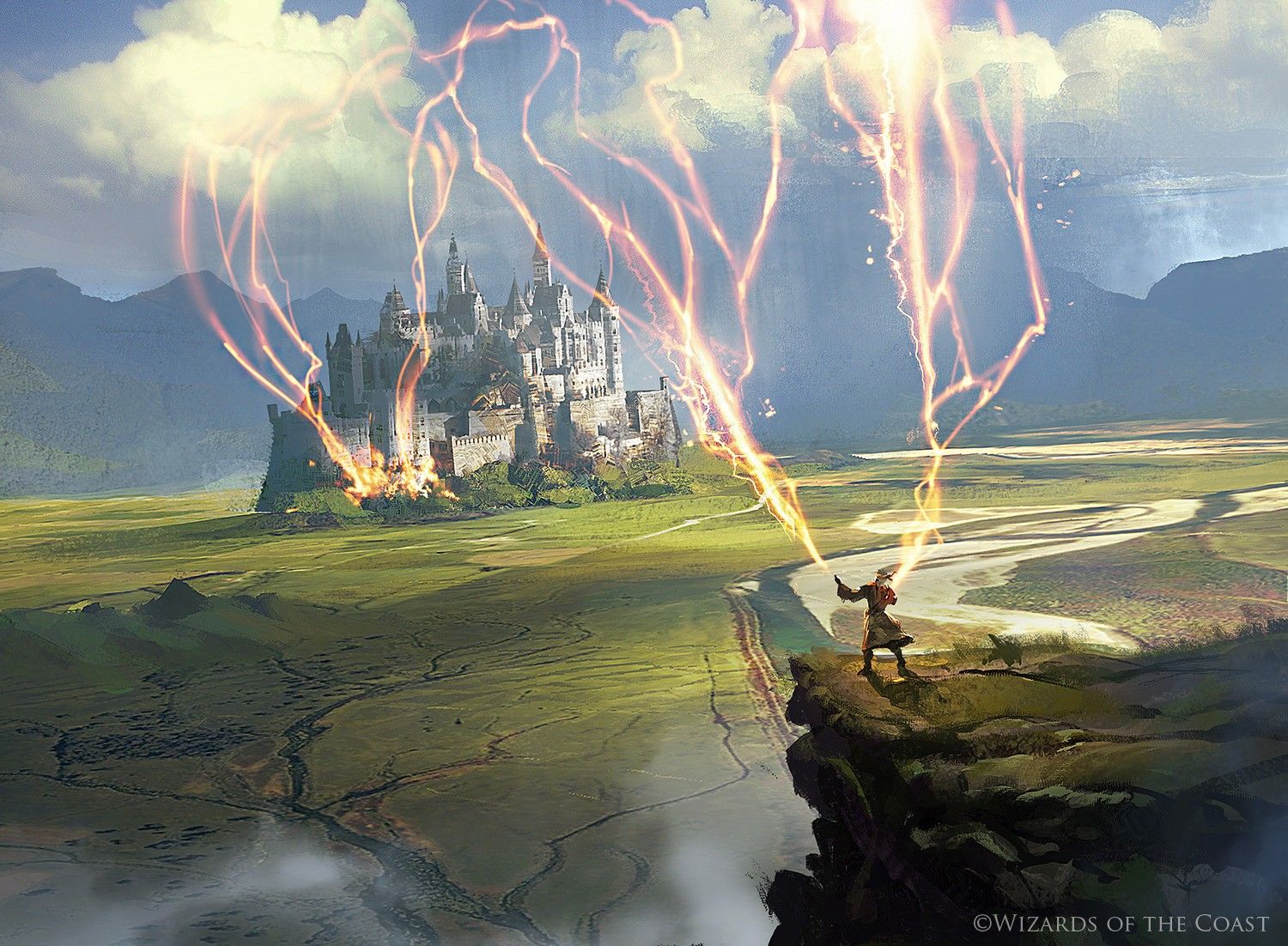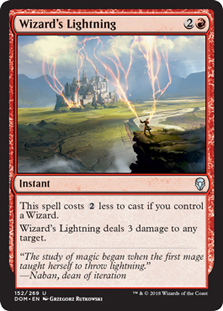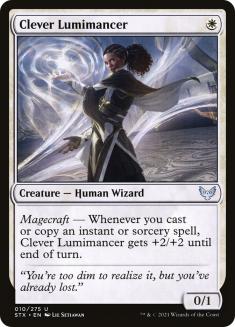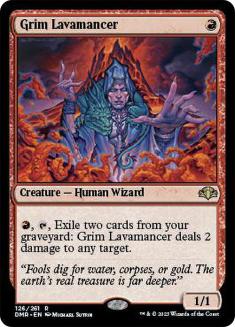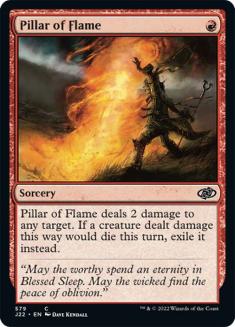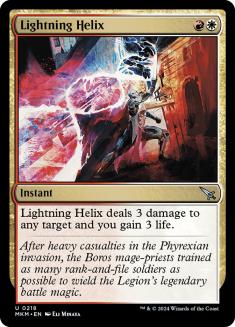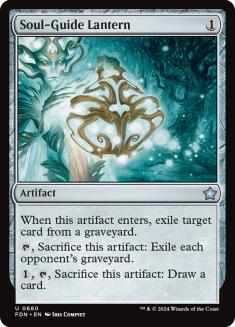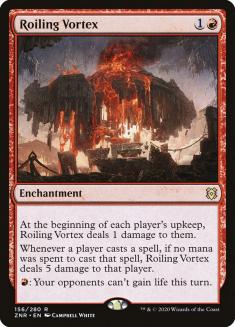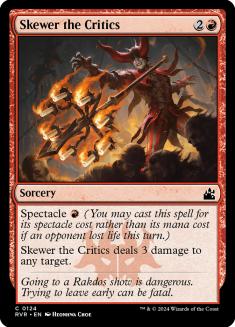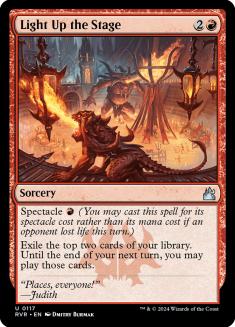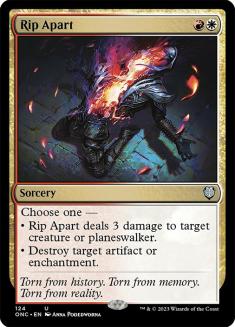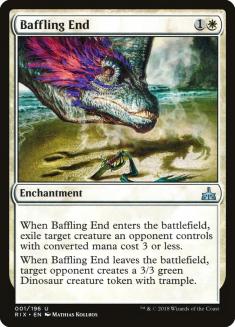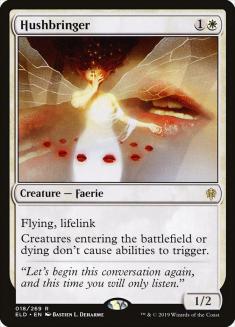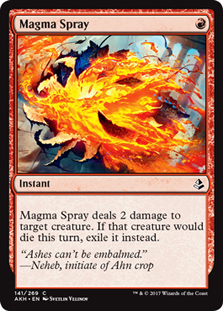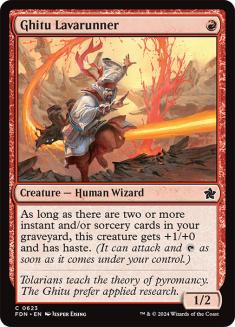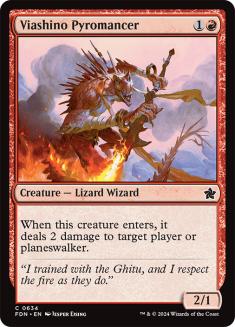In high-powered formats, aggressive decks often succeed because they usually have cheaper tools than the decks around them. As you add more cards to a format’s pool, the aggressive elements start to overlap and you get redundancy. Have enough burn, and you can build an entire deck of Lava Spikes. Have enough virtual copies of Savannah Lions and you can overrun your opponent by spraying the battlefield with efficient threats.
Print enough Wizards and Wizard’s Lightning becomes Lightning Bolt.
In Modern, we’ve seen Burn become one of the greatest decks ever created. It consistently does well in the hands of newer players, offers simple gameplay with elegant deviation among lines, and quite frankly scares me more than any deck I’ve ever played against. An Eidolon of the Great Revel is harder to beat than just about any other card in Magic, but the true strength of Burn lies in creating a vortex of spells that all essentially do the same thing.
It’s hard enough to compete with spells that hit you directly from the stack. When they just burn you out over the course of the first four turns because all their spells cost one mana and deal three damage, you start to understand how inadequately prepared you are to beat them.
Burn decks are often the most misunderstood decks in a given format. While newer players can beat veterans by playing ABC Magic, advanced aggro players like Tom Ross can bluff you out of your shoes and make you play around a combination of cards that aren’t even in their decklist. How you attack, why you attack, and where you point your burn spells can drastically shape a game. Even choosing whether or not to mulligan a weak hand can make all the difference. I love playing aggro decks, specifically red decks, and I love nothing more than coming into a new format and trying things out.
The printing of Clever Lumimancer is quite possibly the best thing to happen to Wizard’s Lightning since its printing. This Steppe Lynx for spells hits really hard when your hand is burn-heavy. It won’t be as degenerate here as it is in Modern, but it’s still very strong, and offers another potent one-drop for our base-Red aggressive strategy.
We’ve seen just how powerful it can be so far in older formats. Historic got a significant boost in power thanks to the Mystical Archive, but there was a severe lack in free instants and sorceries (and that’s a very good thing). It’s incredible how quickly players adopted Mutagenic Growth when the Lumimancer started giving you a bigger incentive to play those free spells. In Historic, we’ll be working a little bit harder for our damage, but that just means we’re building our deck in a very straightforward way. Sometimes…

Grim Lavamancer deserves more hype. I’ve always loved Grim Lavamancer, and I feel like the current Historic format is ripe for a creature that can dominate the battlefield. If our opponent isn’t putting creatures onto the table, it won’t be all that efficient, but it’s a lifesaver if your opponent has to play into it. We aren’t using our graveyard much, so Grim Lavamancer doesn’t counteract our other cards. I’ve tried Grim Lavamancer in a deck featuring Snapcaster Mage or Delve spells before; it was awkward. In aggro decks that don’t have many mana sinks, a single Grim Lavamancer is ridiculous.
Grim Lavamancer slipped into Historic and was never all that good because the format wasn’t really about creatures before. Now, the influx of Collected Company has increased the raw number of creatures you’ll face. New cheap spells that interact with the opponent, like Inquisition of Kozilek, create incentives to play fair decks instead of combo. The banning of a few key combo pieces has also made the format overly fair. That’s exactly the place where Grim Lavamancer can shine.
Creatures (18)
Lands (16)
Spells (26)

I’ve been trying to fit Clifftop Retreat into the deck in small amounts to make casting Clever Lumimancer on the second turn a little easier, but it can only come at the cost of Ramunap Ruins, which is arguably the best land in the deck. It’s actually impressive how good Clever Lumimancer is on the second turn as you try to set up having more than one “prowess” creature, so Clifftop Retreat not being a white source on the first turn isn’t so bad. My gut says that we’ll just have some mana pains until we get another multicolor land like Mana Confluence added to the mix. I’ve liked Mana Confluence a lot in Pioneer, so it should translate relatively well to Historic whenever it does eventually get added.
The deck itself runs smoothly if you have a dual land in the opener, but can play without white mana for some time without trouble. Most of your cards are red, so missing white for a few turns shouldn’t be the end of the world. Our manabases are intentionally bad in Historic because we don’t have fetchlands, so trying to play two different colors of one-drops should be hard.
Pushing Your Deck’s Best Elements
If you’ve played red aggro before, this deck should be nothing new. Wizard’s Lightning is one of the better removal spells in Pioneer, so it only makes sense that getting a few more Wizards in Historic can push it over the top. It’s exciting to get more tools for red aggro that play well with your good cards. Making your best spells even better starts to separate your deck from the rest of the pack. Pushing synergy can generate new power levels that your archetype couldn’t previously attain.
Red decks have had success attacking and burning for years. Pushing their abilities to their absolute limit should be your first inclination. Play to your strengths etc. It just so happens that burn spells are the best thing red can do in most formats. We didn’t get Lightning Bolt proper, but both Skewer the Critics and Wizard’s Lightning can do a pretty good impression when the time calls for it. The versatility and efficiency of Lightning Bolt probably will never be matched. The cards that are almost Lightning Bolt are still good.
Because of Clever Lumimancer, we now have multiple early drops that benefit from spamming burn spells. It can feel like a huge bummer to cast Spikefield Hazard or Shock targeting the opponent when they’re at eighteen life or whatever. That pain significantly decreases when your burn spells supercharge your creature’s abilities. We don’t have Monastery Swiftspear yet, but having two different one-drop creatures doing similar things here is pretty incredible for a fledgling format.
Sideboard Basics
Let’s go over some of the more popular decks in Historic and figure out our gameplans. We’ll continue to be the aggressor mostly, but in some situations cards like Grim Lavamancer can gain immense value. In those cases, playing a little more controlling and understanding your role is important. On other occasions, throwing a burn spell at a creature instead of going face when they’re at seventeen life can lose you the game. Regardless, each scenario deserves independent consideration, but your approach to each matchup should match your overall gameplan.
VS Jeskai Control
Creatures (3)
Planeswalkers (6)
Lands (21)
Spells (30)

Let’s start with one of the more popular control decks in the format: Jeskai Control. Michael Majors has an excellent recent primer on it.
To call this a control deck doesn’t really do it justice. Sure, it plays like a normal control deck for about 60% of the time, but then it just goes full wombo-combo and casts Magma Opus on the third turn and decimates most opponents. That kind of raw power in the early turns might not necessarily win them the game, but it gives them such a burst of resources and battlefield control that it’s hard to overstate just how good it actually is. Against you, they’ll be reliant on Lightning Helix to regain some lost life and contain your creatures, but there’s a good chance you can overwhelm them with a fast start.
An early Magma Opus is tough to beat. That’s why they play it. With so many creature decks running around, having an early way to spray down multiple creatures while creating a 4/4 is outrageous. With that said, these versions are a little light on Mizzix’s Mastery, but the threat remains and ramping into Torrential Gearhulk via Treasure tokens is very real.
Wrath of God is one of their better cards against you. Understanding when to play around it and when to ignore it is key, as when playing any aggro deck. The hard one-two punch comes from cleaning up your creatures and then gaining life to get out of burn range. A single Lightning Helix might not end you, but two or three with a Torrential Gearhulk thrown in could be devastating. Our plan is to spray the battlefield early with threats and hope our burn spells can finish the job.
Out:
In:
All your threats are good here, so I’m trimming our weaker burn spells. I think Lightning Helix shines against creatures but is relatively weak against control, even though it deals more damage. Because of spectacle and our “prowess” creatures, Shock gets the nod because it’s slightly cheaper and doesn’t require white mana. Soul-Guide Lantern and Roiling Vortex are excellent here, providing you with a few cards that reduce their gameplan to ashes. While Soul-Guide Lantern is solid, drawing two is lackluster. It might give them enough time to claw back into the game.
VS Jund Sacrifice
Creatures (20)
Lands (22)
Spells (18)

Jund Sacrifice is typically favored against creature-based decks. Their cards are specifically designed to gain life, punish opponents who cast threats onto the battlefield, and squeeze your resources until their recursive threats get the job done. With that said, our deck is a bit faster than what they’re used to dealing with, so we could get the jump on them and maybe overwhelm them before they can get things set up.
Grim Lavamancer is crucial in this matchup, machine-gunning down their mediocre threats so they have fewer creatures for their engines. If you can get them low enough, you might be able to burn them out, but the constant lifegain from Cat-Oven is tough to overcome. After sideboard, things could get a little better, but I’m not optimistic.
Out:
In:
Clever Lumimancer and Skewer the Critics are both excellent when your opponent doesn’t have blockers. In this matchup, Clever Lumimancer can’t attack without help and gets chump-blocked too often. Skewer the Critics is also poor against creature-based decks, as it takes away the Lava Spike mode on the regular.
Hushbringer is surprisingly good here, shutting down a lot of their antics. All our graveyard interaction and exile removal is key, and Rip Apart killing Witch’s Oven is a nice backdoor. I love Rip Apart here specifically because it can be used a lot of different ways. Versatility is clutch here; clearing an annoying creature like Mayhem Devil or wiping their engine off the battlefield is incredible utility.
VS Dimir Rogues
Creatures (12)
Lands (20)
Spells (28)

Dimir Rogues should be relatively easy. They can’t gain life and all their threats get scorched by your cheap removal. Their best draws rely on sticking something for battlefield presence and having all their tempo plays generate psuedo-card advantage. They don’t have sweepers, and their spot removal isn’t torrential enough to keep your threats in check. With your many cheap creatures, particularly Grim Lavamancer, I think this matchup should be relatively easy. With that said, Dimir Rogues is a great deck and you shouldn’t sleep on it. They can be really tricky and steal some games if you aren’t careful.
Out:
In:
Usually Magma Spray comes in to supplement your removal and give you some exiling for troublesome creatures. Here we’re just slightly upgrading our removal because sorcery-speed spells are not good against flash-based opponents. They have a reasonable number of creatures that need killing, yet also play the games out like a control deck, so it is our job to apply pressure while dancing around a few of their smaller threats. Balancing creatures and removal is key, and our deck is already well set up to take them down.
VS Dimir Tainted Pact
This matchup is a lot like Dimir Rogues in that you’re absolutely the aggro deck. Here, though, you don’t have to worry about taking out their creatures. Instead, you have to play a longer game (most of the time) while dodging their combo. Red decks are usually some of the best at doing exactly that.
Out:
In:
A constant way to deal damage that doesn’t die to removal is clutch. As I said, they’re playing like a control deck until the turn where they kill you. Treat them like a control deck, and beat them like one. We have very little disruption for their combo, so we should emphazie the way we can interact: killing them quickly. Skewer the Critics is excellent here, as are all of our “goldfish”-type cards. They aren’t putting up blockers too often so all our spectacle cards should be absurd.
I wouldn’t fall into the trap of Hushbringer if I were you. It doesn’t do enough and dies pretty easily. Were it a larger threat on its own, I wouldn’t mind so much, but one power isn’t enough against control.
VS Gruul Aggro
Creatures (33)
- 4 Llanowar Elves
- 4 Scavenging Ooze
- 4 Burning-Tree Emissary
- 4 Voltaic Brawler
- 3 Ahn-Crop Crasher
- 4 Pelt Collector
- 4 Gruul Spellbreaker
- 1 Questing Beast
- 4 Bonecrusher Giant
- 1 Kazandu Mammoth
Lands (13)
Spells (14)
Sideboard

Gruul Aggro is one of the major reasons why Grim Lavamancer should be seeing more play. It doesn’t kill their biggest creatures, but helps combine with small burn spells to get the job done. It sits on the battlfield and chews through their front lines. It’s absurd. It also dies to Stomp, which is why we’re playing three.
This matchup can be tough because their creatures outsize ours. Still our deck is so efficient that we might be able to clobber them before they get off the ground. Our cheap removal can contain their early threats, but it all depends on the build. For now, I think we’ll be okay because people are moving away from Lovestruck Beast. These decks look more red splashing green than vice versa, which bodes well for a deck full of Shocks.
Out:
In:
This is one of those rare cases where we actually have the tools to play a longer game and win. That’s why we remove our worst one-drop threat, Ghitu Lavarunner, and go hard on ways to interact with their creatures. With that said, if you’re facing the version with Collected Company and/or Lovestruck Beast, this plan might not work. If you’re facing that version, take out Light Up the Stage. Connecting and having those cards be good is actively difficult.
VS Selesnya Company
Creatures (33)
- 4 Llanowar Elves
- 3 Scavenging Ooze
- 1 Rhonas the Indomitable
- 4 Lovestruck Beast
- 4 Skyclave Apparition
- 4 Archon of Emeria
- 4 Luminarch Aspirant
- 4 Kazandu Mammoth
- 1 Reidane, God of the Worthy
- 4 Elite Spellbinder
Lands (20)
Spells (7)

This deck, like all Collected Company decks, can be nightmarish. Their creatures just outclass ours and our removal doesn’t get the job done. With that said, the emphasis on Collected Company does tend to lower the size and casting cost of the opposing creatures a bit, which can unlock our removal to actually function instead of rotting in our hand. Lovestruck Beast will be problematic no matter what we do.
Grim Lavamancer shines here, popping most of their smaller threats and stifling a lot of their early development. It’s also one of our only ways to regain true card advantage in the face of cards like Collected Company, as trading one-for-one on burn spells for those two creatures is a nightmare.
Out:
In:
Viashino Pyormancer is a bit weak here, as it gets bricked off on the battlefield by the Human token on Lovestruck Beast and a number of other mediocre creatures from the opponent. As the most expensive creature in the maindeck, having no synergy with Hushbringer, the swap is relatively easy.
Hushbringer should cause some serious problems, and Baffling End should help contain most of their threats. Funny how Collected Company and Baffling End are like two puzzle pieces that fit together to form interaction webs!
VS Izzet Phoenix
Creatures (12)
Lands (18)
Spells (30)

A relatively easy matchup. They can pressure you with some early copies of Arclight Phoenix, but we have some exile effects, cheap interaction, and a straightforward plan that isn’t decimated by cheap removal. They can keep our early threats in check but they don’t have some game-ending threat we can’t beat. Thing in the Ice isn’t around in this format, which means they can’t steal games they have no business winning.
Out:
In:
Soul-Guide Lantern can shut down their only real threat against you in Arclight Phoenix, so it’s good to bring those in as a safety valve. With that said, you should win this matchup more often than not, even if they’re going hard on Arclight Phoenix. They have Faithless Looting now, but they’re slower than in Modern without free spells.
Lumimancer is not attractive to me here without the “kill your creature, get in for more damage” play pattern. Instead, it forces us to throw all our burn upstairs, only to see Lumimancer squashed by a single removal spell. I think Grim Lavamancer is equally mediocre, but has some value if their draw is creature-heavy. They basically have to kill it before playing Sprite Dragon because it will be so hard to protect it.
Lightning in a Bottle
Red decks are often good enough in a given format to stand on their own. I think the current iterations in Historic can be built a bunch of different ways to include things like Bonecrusher Giant, but this build featuring Lurrus of the Dream-Den just hits differently. I like being low to the ground, relying on cheap creatures to do the first few points of damage, only to have your clean-up crew of Wizard’s Lightning and Skewer the Critics finish the job. There are ways to exploit this strategy, but that’s true of every archetype and build.
My favorite part of Historic right now is how diverse the metagame actually is. If you go back and look at the decks I’m preparing to beat, you’ll notice just how many decks are at the front of the format, let alone those sitting just a step behind. There has been a big emphasis on Historic lately thanks to the Mystical Archive cards. It’s probably my favorite format to brew in right now, and miles ahead of Pioneer in terms of enjoyability thanks to fan favorites like Brainstorm. The games are intense, but also heavy with tough decisions. There are also very few combo decks running around, though Thassa’s Oracle bears watching.
If you’re into aggro and haven’t dug your teeth into Historic yet, I highly recommend giving this deck a try. It’s fun, full of cool play patterns, and has some interesting design choices that are hard to play with but rewarding when you pull them off. Just figuring out when to shove on Clever Lumimancer can be tough!
I’ll likely be writing and playing Historic only for the next few weeks unless something in Modern grabs my attention. The format is deep and has a lot of eyes on it at the moment. Check back next week to see if I broke it!

